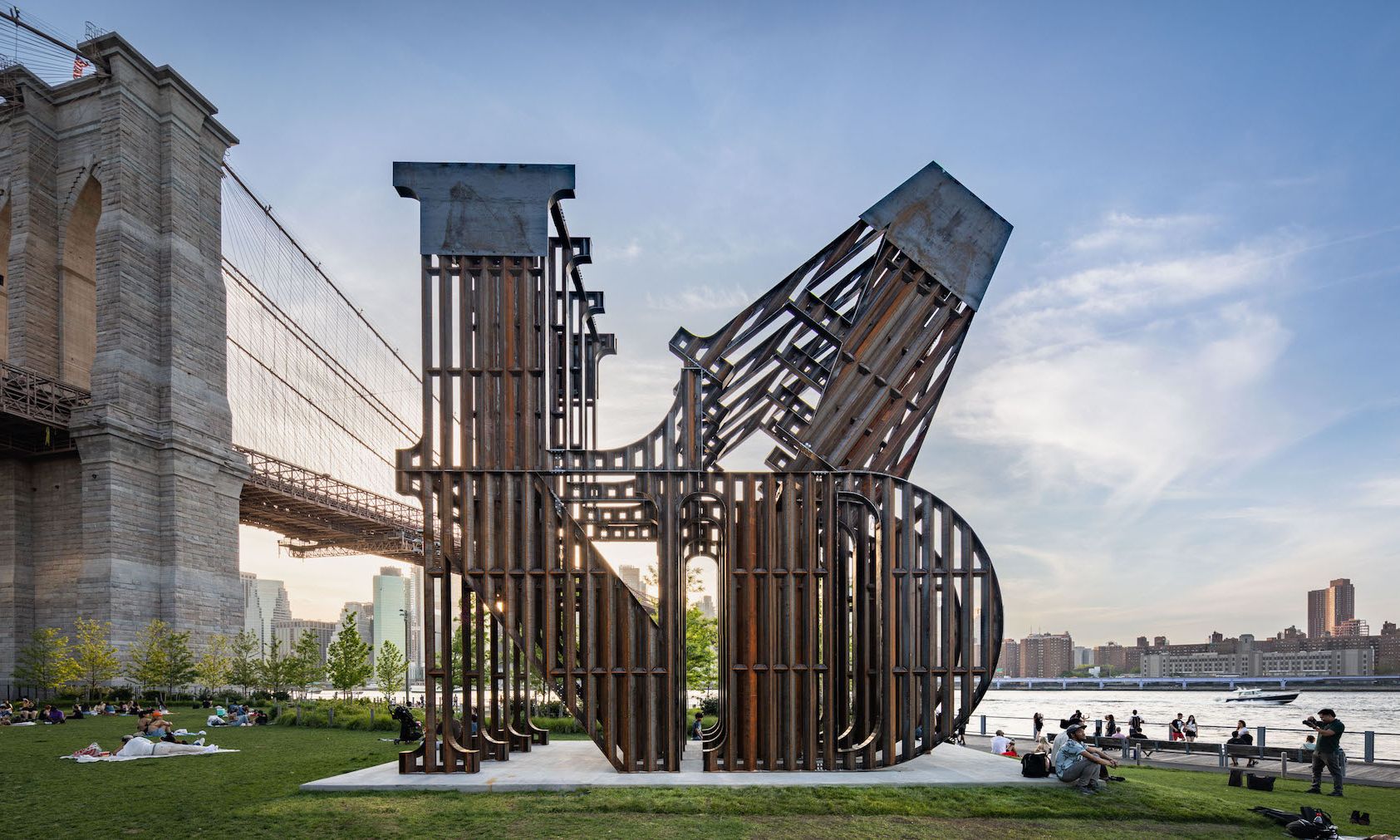Nicholas Galanin, In every language there is Land / En cada lengua hay una Tierra, 2023 Courtesy of the artist and Peter Blum Gallery
Photo: Nicholas Knight, courtesy Public Art Fund, New York
Speaking from his home in Sitka, Alaska, the Tlingit and Unangax artist Nicholas Galanin discussed his new public sculpture In every language there is Land / En cada lengua hay una Tierra (2023), a Public Art Fund project in Brooklyn Bridge Park, situated with a view of Manhattan and the East River. Made from the exact steel used in the construction of the wall along the border between the US and Mexico—and with the same imposing 30ft height as the wall—he repurposed the material to spell the word “land” in a fashion that recalls Robert Indiana’s famous LOVE works.
The Art Newspaper: How did you arrive at the title, In every language there is Land / En cada lengua hay una Tierra?
Nicholas Galanin: The work is about language and land, so specifically this title utilises English and Spanish, the two colonial languages on either side of the US-Mexico border. The material of the work came directly from the border wall construction, so this would have been the wall if the material hadn’t instead become this piece. There is only one company that fabricates the material for the border wall, and the steel that was sourced here was en route to be part of it, but we were able to divert it for this project. With that, I’m looking at how so much is intentionally removed through colonialism: Indigenous people, Indigenous land and their relationship to it—and language.
Portrait of Nicholas Galanin
Photo: Merritt Johnson
So again, the language reference of this understands that not only is it a physical history and space, but this type of colonialism and genocide takes many forms, and that’s especially experienced through our languages. I come from Tlingit and Unangax background, and I have an ancestral lineage here in southeast Alaska, and one of the largest cultural battlefields is language. We’re still dealing with that now, where there is revitalisation of language in relationship not only to our culture and history, but also to place and place names. This work is in conversation with that.
I’m thinking about this extremely loaded material choice, and I know that material, with all of its history and mythology, has often been so central to your work.
Yes, and land and history of place have been as well. For me, a few things are brought together in this work: one is that there is a contrast in this work in reference to Robert Indiana’s LOVE (1970) sculpture, which is more Pop iconography, as well as the language or idea of love. And my understanding is that there is a religious history or background in that work, too. So how far is that extended with the home? And when we talk about Indigenous histories and nationalism and borders and colonial violences, there is a very clear distinction of who and for whom.
Nicholas Galanin, In every language there is Land / En cada lengua hay una Tierra, 2023 Courtesy of the artist and Peter Blum Gallery
Photo: Nicholas Knight, courtesy Public Art Fund, New York
Another big part of this conversation is the violence of national border walls and the root of that— whether it’s capitalism or other forms of government power—and what those walls ignore as they cut through Indigenous land or Indigenous waterways, and not only for humans but for who we share the land with, too.
Yes, I remember seeing videos of ancient cacti being cut down to make way for the wall. Thinking of language, the work is situated with a view of Manhattan, and Manhattan is of course an Indigenous word.
Yes, the East Coast especially in terms of the pathways of colonisation and the histories of this westward expansion—manifest destiny and all of that. There’s a lot of conversations and relationships still happening as extensions of this, whether it’s current situations where we are faced with these similarly enforced barriers and borders for specific communities, or we’re looking forwards at how that will change with the climate crisis and which communities will be faced with the worst hardships.
Nicholas Galanin, In every language there is Land / En cada lengua hay una Tierra, 2023 Courtesy of the artist and Peter Blum Gallery
Photo: Nicholas Knight, courtesy Public Art Fund, New York
Given that it’s going to be in a public space occupied by a wide variety of people—New Yorkers, national and international tourists and so on—what do you think about the meaning of the work and of the word “land” being so open to different interpretations?
Everyone has their own perspectives when they approach these things, and I feel like a lot of my work holds a mirror to one’s perspective and how they may feel complicit or whatever their relationship to it may be. Especially in conversations around land in a place like New York today, and in conversations of migration and movement across land and borders, these are conversations that extend far beyond the US-Mexico border. Everyone has stories and relationships to where they’re at and how they got there, and I hope this work allows for that to be heard, understood and reflected upon.

